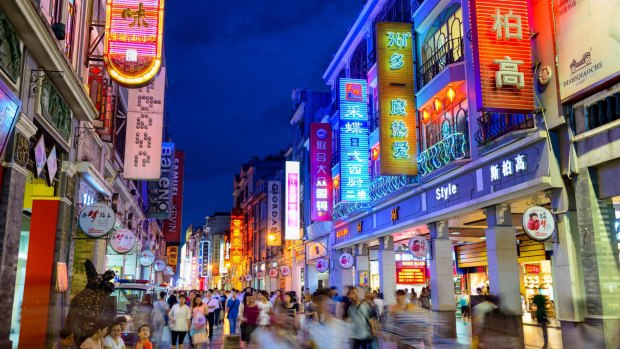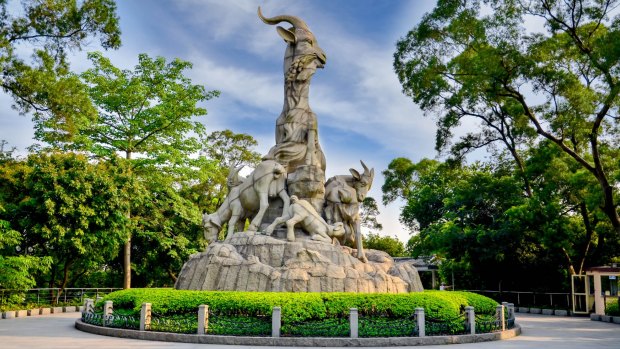This was published 5 years ago
Guangzhou, China: An economic powerhouse filled with friendly people and food
By Sue Williams

The streets are always the main lure in Guangzhou.Credit: Shutterstock
The man is staring at me curiously across the busy restaurant, and I smile back. It's all the encouragement he needs.
The next moment, he's bounding over, his toddler son squirming in his arms. He evidently wants to give him his first introduction to a foreigner but the child has other ideas. He takes one look at me and starts bawling at the top of his voice. And despite all his embarrassed father's ministrations, the screaming continues, long and awfully, awfully loud.
"Sorry, sorry," the father splutters, forced into making a tactical retreat. "Bye bye, bye bye," he calls out as he stumbles back to his own table.

Yuexiu Park, in the city's north.Credit: Shutterstock
I look at him sympathetically. I appreciate the gesture of friendship. Maybe the next time, his son might too.
It has been 34 years since I last visited Guangzhou in southern China and so much has changed in the interim. A whole new city has been built alongside the old town Canton, the place is now incredibly clean and tidy, its tourist attractions are well presented, it has become an economic powerhouse of prosperity and industriousness and the people ... the people have changed beyond recognition.
In 1985, not so long after the end of Mao Zedong's Cultural Revolution, everyone had been dressed almost exclusively in either green army uniforms or navy blue Mao suits, was nervous and suspicious of foreigners, especially those travelling alone, and wanted as little to do with us as they could.
But today, they're colourfully fashionable and falling over themselves to be as friendly and as welcoming as possible.
Quite apart from parents thrusting their babies at me, older children are happy to play mock martial arts fighting games, family groups ask to have their photos taken with me, a couple of young men who are professional dancers are keen to chat about their lives and elderly men are suddenly wreathed in smiles.
A police officer approaches on the street one day and for a moment I'm transported back 33 years. I'd got off a train between Guangzhou and Shanghai (those days a 23-hour journey on one class – hard seat – now seven hours high speed with plenty of classes) at a little town in the middle of nowhere, determined to see the "real" China.
I didn't have the necessary Alien's Travel Permit to be there, and knew my Foreign Exchange Certificates (we had to use those instead of regular currency) would be useless, but thought I'd be right. I wasn't. I was immediately approached by a policeman who, to my shock, addressed me by name. "Miss Williams," he said, "get back on the train!"
But today, this officer has a different intent. "Hello!" he says. "Happy New Year!" It is March, but no matter. The gesture is appreciated and we shake hands on it.
"I think a lot of foreigners don't realise how friendly we are in Guangzhou," says local tour guide Maggie Ho. "We are quiet and gentle and very welcoming, and we say sorry if we bump into anyone.
"We are very different to people in the north of the country who can be much louder and more aggressive and rude ... The difference is that people in the north eat wheat and we eat rice, so they're bigger, like westerners. We're smaller and softer and polite."
To the outside world, Guangzhou's charms have indeed been regularly overlooked in favour of China's big-ticket attractions: Beijing with its Tiananmen Square and Forbidden Palace, Chengdu with its giant pandas, various sections of the Great Wall, Xian and its Terracotta Warriors and sophisticated Shanghai. But, increasingly, Guangzhou, the starting point of the legendary "Maritime Silk Road", is taking its rightful place as a fascinating centre for travellers to spend some time, even if en route to elsewhere.
Quite apart from the friendliness of the people, there's the food. There's an ancient Chinese saying that, for the perfect life, you need to be born in Hangzhou (which has the best scenery), marry in Suzhou (where the most beautiful women reside), eat in Guangzhou and die in Liuzhou (where the forests make the most handsome of coffins).
Cantonese cuisine is recognised as one of the world's great gastronomies, with its dishes renowned for their freshness, variety and innovation. Yum cha and dim sum dumplings are everywhere, while every street reveals a new speciality, from street stalls selling rice noodles to tiny local cafes and grand restaurants with multiple chandeliers and telephone book-sized menus.
There's plenty to see between meals, too. The Six Banyan Liurong Temple, dating from 537AD, is a stunningly beautiful and peaceful cultural shrine, with its 56-metre-high, intricately-carved pagoda, flanked by 170-year-old Banyan trees.
Inside one of its buildings, the Merit Hall, an elderly man negotiates with the attendant over the price of a spot to place his ashes when his time comes. Outside, another man urges me to walk three times around the tower, reciting words I simply can't replicate to his satisfaction to bring good luck.
Across town is the 11th-century Foshan Ancestral Temple, with its fascinating displays of martial arts and an exhibition on the history of Yip Man, the legendary Wing Chun master who taught Bruce Lee all he knew.
There's also a traditional Xiguan residence – including a room in which the women sat and watched the men going about their business through a slit window looking down on the courtyard – which is now part of the delightful Liwan Museum.
The streets are always the main lure, however. They teem with life, as street sellers call out their wares, families wander through, groups of young men and women chat on their way to the teahouses, and crowds gather to watch frequent lion dances, often breathtakingly acrobatic. Along the Pearl River that slices through the city, people exercise intently, and don't seem to mind at all if you join them.
The pet market showcases every kind of animal you can imagine, from turtles and birds to cats and mice, while couples stroll along the wide leafy avenues of Shamian Island. As the quarter that was used by foreign traders and now houses overseas embassies, it feels much more Parisian than Chinois.
The shopping's pretty out of this world, too, but that shouldn't be a surprise. Traders, after all, have been visiting this part of the world since the Qing dynasty, and today's equivalent, the Canton Fair, sees 25,000 exhibitors and more than 200,000 buyers attending every session from more than 210 countries around the world.
Curiously, on the streets, there's also none of the constant cacophony of hooting and yelling that makes some south-east Asian roads deafening. Maggie Ho looks mystified when I mention it. "But why would we make noise?" she asks sweetly.
There are fabulous gardens too, particularly around the base of Baiyan Mountain with bright floral displays at the Yuntai Garden reminding you of Guangzhou's moniker as the City of Flowers, a sculpture park and an aviary inside a valley of rocks and streams and white peacocks displaying what looks like snowy embroidered lace. The cable car to the top of the mountain is a heart-stoppingly scenic ride.
Another highlight (sorry!) is the tallest TV tower in China, and the third highest in the world, the Guangzhou Tower, at 604 metres, with the loftiest outdoor observation deck on earth, at 488 metres.
There, you can choose to try the Sky Drop, the highest vertical free fall in the world (no, thanks), or the bubble tram, a cute series of carriages that revolve, corkscrew-like, around the tower. Unfortunately, the weather's so bad the day I go, all I can see is cloud and it's not until the lift's racing down the side of the building that gradually the cityscape below forms.
But somehow it just doesn't matter. Back down among the people, the food and the more earthly sights, that's where today's real charm of Guangzhou lies.
WHAT NOT TO MISS IN GUANGZHOU
1.Trying the food on the street, in cafes and top restaurants.
2.The street life, with people thronging to favourite eating spots, older ones exercising in parks and young brides queuing on Shamian Island for pre-wedding photos in scenic spots.
3. Six Banyan Liurong Temple which has not one, not two, but three massive Buddhist statues.
4.The Taoist Foshan Ancestral Temple has regular displays of martial arts and lion dances
5.Baiyan Mountain, with the cable car trip to the top.
6.Guangzhou Tower offering – in good weather – a bird's eye view of the city.
TRIP NOTES
FLY
China Southern Airlines flies 24 times a week to Guangzhou from Sydney and Melbourne, seven times a week from Brisbane and Adelaide, four times a week from Cairns and five times a week from Perth in high season. See csair.com.au
STAY
LN Hotel Five is a 4.5-star boutique art deco hotel on the Pearl River, with only 34 rooms, a restaurant, gym and panoramic views of the water, boats floating by and the city skyline from its seventh level rooftop bar. See lingnanhotelfive.com
TOUR
Wendy Wu Tours offers tours of Guangzhou and comprehensive itineraries spanning the whole of China. wendywutours.com.au
MORE
Guangzhou Tourism gzly.gov.cn
Sue Williams was a guest of Guangzhou Tourism and China Southern Airlines
Sign up for the Traveller Deals newsletter
Get exclusive travel deals delivered straight to your inbox. Sign up now.